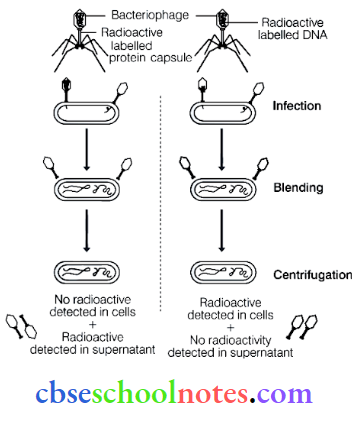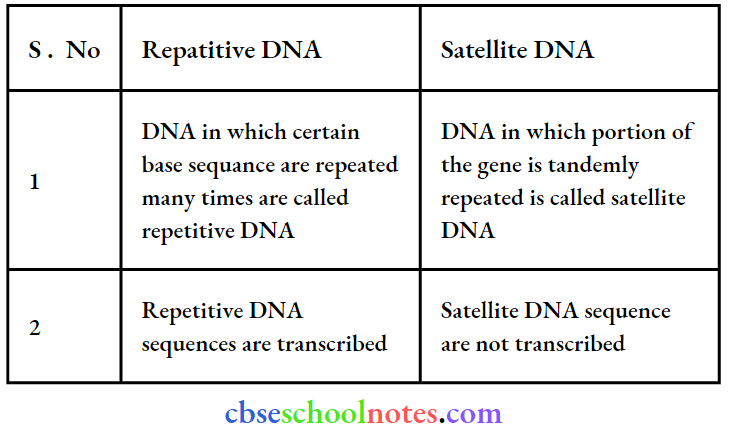Molecular Basis Of Inheritance Questions And Answers
Question 1. Group the following as nitrogenous bases and nucleosides: Adenine, Cytidine, Thymine, Guanosine, Uracil, and Cytosine.
Answer:
Nitrogenous bases-Adenine, Thymine, Uracil, and Cytosine Nucleosides-Cytidine and Guanosine.
Question 2. If a double-stranded DNA has 20 percent cytosine, calculate the percent of adenine in the DNA.
Answer:
Cytosine 20%, therefore Guanine = 20%
According to Chargaff’s rule,
A+T =100 – (G + C) ‘
A+T =100-40. Since both adenine and thymine are in equal amounts
Thymine = Adenine=60/2=30%
Question 3. If the sequence of one strand of DNA is written as follows:
5′-ATGCATGCATGCATGCATGCATGCATGC-3′
Write down the sequence of the complementary strand in the 5′ → 3’ direction.
Answer:
In 3′ 5′ direction, 3-TACGTACGTACGTACGTACGTACGTACG-5′
In 5′ → 3′ direction, 5-GCATGCATGGATGCATGGATGCATGCAT-3
Question 4. If the sequence of the coding strand in a transcription unit is written as follows:
5-ATGCATGCATGCATGCATGCATGCATG-3′
Write down the sequence of niRNA.
Answer:
5′-AUGCAUGCAUGCAUGCAUGCAUGCAUG-3′
Read and Learn More Class 12 Biology Chapter Wise
Question 5. Which property of the DNA double helix led Watson and Crick to hypothesize a semi-conservative mode of DNA replication? Explain.
Answer:
Watson and Crick observed that the two DNA strands are antiparallel, and have opposite polarity. This means that the 5′ phosphate of one strand faces the 3′ hydroxyl group of the other strand and that the 5′ phosphate group of two strands are present in opposite positions. The antiparallel arrangement of two helices allows hydrogen bonding between amino and carbonyl groups of complementary base pairs; This led them to the hypothesis of die semiconservative mode of DNA replication where two strands of DNA first separate from each other followed by copying of each template strand to form DNA molecules each carrying one parental strand and newly synthesized strands.

Question 6. Depending upon the chemical nature of the template (DNA or RNA) and the nature of nucleic acids synthesized from It (DNA or RNA), list the types of nucleic acid polymerases.
Answer:
DNA template
- DNA polymerase for DNA replication.
- RNA polymerase for RNA synthesis or transcription.
RNA template
- RNA-dependent RNA polymerase for synthesis of RNA in some RNA viruses.
- Reverse transcriptase to synthesize cDNA (complementary DNA) over RNA template.
Question 7. How did Hershey and Chase differentiate between DNA and protein in their experiment while proving that DNA is the genetic material?
Answer:
Hershey and Chase (1952) conducted experiments in bacteriophages to prove that DNA is the genetic material.
Procedure:
- Some bacteriophage viruses were grown on a medium that contained radioactive phosphorus (32P) and some in another medium with radioactive sulfur (35S),
- Viruses grown in the presence of radioactive phosphorus (32P) contained radioactive DNA.
- Similar viruses grown in the presence of radioactive sulphur (35S) contained radioactive problems.
- Both the radioactive virus types were allowed to infect Exoli separately.
- Soon after infection, dead bacterial cells were gently agitated in a blender to remove viral coats from the bacteria.
- The culture was also centrifuged to separate the viral particle from the dead bacteria cell.
Observation and Conclusions:-
- Only radioactive (32P) was found to be associated with a bacterial cell, whereas radioactive (35S) was only found in the surrounding medium and not in the bacterial cell.
- This indicates that only DNA and not the protein coat entered the bacterial cell.
- This proves that DNA is the genetic material that is passed from vims to bacteria and not protein.

Question 8. Differentiate between the following;
- Repetitive DNA and satellite DNA
- mRNA and tRNA
- Template strand and coding strand
Answer:
1. Repetitive DNA and satellite DNA

2. mRNA and tRNA

3. Template strand and coding strand

Question 9. List two essential roles of the ribosome during translation.
Answer:
Two essential roles of the ribosome during translation are:
- One of the rRNA (23S in prokaryotes) acts as a peptidyl transferase ribozyme for the formation of peptide bonds
- Ribosome provides sites for attachment of mRNA and charged (RNAs for polypeptide synthesis)
Question 10. In the medium where E.coliwas growing, lactose was added, which induced the Sac operon. Then, why does the lac operon shut down sometime after adding lactose to the medium?
Answer:
This is because the repressor protein binds to the operator region of the operon and prevents RNA polymerase from transcribing the operon.
Question 11. Explain (in one or two lines) the function of the following:
- Promoter
- tRNA
- Exons
Answer:
- Promoter: It is the segment of DNA that lies adjacent to the operator and functions as the binding site for RNA polymerase to carry transcription if allowed by an operator.
- RNA: It acts as an adaptor molecule that picks up a particular amino acid from cellular poll and takes the same over to site A of mRNA for incorporation into a polypeptide chain.
- Exons: These are die-coding segments present in the primary transcript, which after splicing join to form functional mRNA.
Question 12. Why is the Human Genome Project called a mega project?
Answer:
The Human Genome Project is called a mega project for the following reasons:
- Sequencing of more than 3 x 109 bp.
- Identification of all the approximately 20,000-25000 genes in human DNA.
- High expenditure of more than 9 billion US dollars
- Identification of all die alleles of genes and their functions.
- Storage of data for sequencing would require space equal to 3300 books of 1000 pages each if each page contains 1000 letters. ‘
Question 13. What is DNA fingerprinting? Mention its application.
Answer:
DNA fingerprinting is a die technique to determine die relationship by studying the similarity and dissimilarity of VNTR (variable number of tandem repeats), its applications are:
- It is used as a tool in forensic tests to identify criminals.
- To settle paternity disputes.
- To identify racial groups to study biological evolution.
Question 14. Briefly describe the following:
- Transcription
- Polymorphism
- Translation
- Bioinformatics
Answer:
1. Transcription: It is the formation of RNA over the template of DNA. It forms single-stranded RNA which has coded information similar to the sense or coding strand of DNA, except that thymine is replaced by uracil.
2. Polymorphism: Genetic polymorphism means the occurrence of genetic material in more than one form. It is of two major types, i.e. allelic polymorphism and SNP.
- Allelic polymorphism: Allelic polymorphism occurs due to multiple alleles of a gene Alleles possess different mutations that alter the structure and function of a protein formed by, as a result, a change in phenotype may occur.
- SNP or single nucleotide polymorphism: Over 1.4 million single-base DNA differences have been observed in human beings. According to SNP, every human being is unique. SNP is very useful for locating alleles, identifying disease-associated sequences, and tracing human history.
3. Translation: It is a dying process during which the genetic information stored in the sequence of nucleotides in mRNA molecules is converted following the direction of the genetic code into a die sequence of amino acids in the polypeptide. It takes place in the cytoplasm in both eukaryotes and prokaryotes.
4. Bioinformatics: The science that deals with handling, and storing huge information of genomics as databases, analysing, modelling, and providing various aspects of biological information especially the molecules connected with genomics and proteomics is called bioinformatics.
